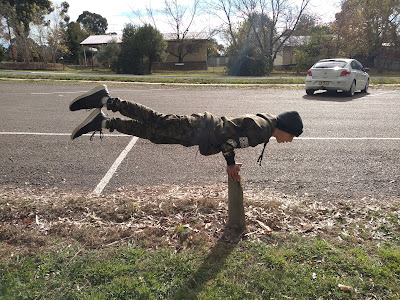I have always been skinny. Sometimes I was skinny and strong, other times I was skinny fat. Skinny fat sounds like an oxymoron, but it is a real thing. Most people who put on weight gain subcutaneous fat, which is fat under the skin. As this is very common in this society it is what we think of when we hear the term 'fat'. 'Skinny fat' is where I had little muscle and too much visceral fat - fat around my organs. Skinny fat is far less common in our society of extravagant lavish excess.
I am getting older, so any form of exercise is more difficult. I also have a job, and have kids, so I have little time for exercise. I've had a few accidents over the years and have been told by specialists that my body will degrade to the point where I will have to retire by the age of 50 due to pain. Retiring early due to pain sounds like a dreadful existence, so I decided that I needed to do something about it.
I figured getting strong should help slow this degradation, and getting strong while I am young(er) should be a whole lot easier than waiting until I am older and in more pain before trying to build strength. Hopefully getting stronger now will help me stay more able for longer, there is only one way to find out, and that is by getting in and trying.
A few years ago I started a form of strength training known as prochnost. Prochnost is a Slavic word meaning something along the lines of strength, durability, toughness, stability, hardness, solidity etc. It is pronounced proach-nests, and in Cyrillic is written прочность. This type of training uses mostly body weight exercises, often training several muscle groups (or whole body) at the same time, and focusses on training for strength and ability rather than size.
Since beginning prochnost training a few years ago I have become vastly stronger, I am stronger now than I have been in the past decade, and am possibly almost as strong as I have ever been. That's not too shabby considering my age and how little time I put into training. I am also in less pain now than I was before prochnost training, so if nothing else it has been worth it to be in less pain.
I have started a fitness blog to record my progress, as well as the progress of my kids. I plan to keep this blog going, but they are about very different things so I figured they would be better as separate blogs. If you are interested in having a look, the new blog can be found here: https://skinny-fat-fitness.blogspot.com/
I wanted to call the new blog Old Man Strength, but there is a company with that name, and that company does 'fitness' things very differently than I do, in some ways it is almost the opposite. So I needed to think of another name. I am skinny, I have been skinny fat, and the blog is about fitness. Skinny fat people must train differently to achieve results, which is what the skinny-fat-fitness blog is about.
My kids also do a little prochnost training with me as they think it is fun, they are skinny and incredibly strong. Body weight exercises are safer for kids to train rather than using free weights. Some of these exercises also look rather impressive.
When I take my kids for a walk they tend to do a little training, often young fit men see this, and give it a go themselves, and they usually fail. There is something about watching a fit man in his mid 20's being out done by a ten year old that puts a smile on my face.
My twelve year old is stronger than you.
 |
| Bent arm planche |
 |
| Elbow lever off a park bench |
 |
| Elbow lever off a rock |
My ten year old is stronger than you
 |
| Elbow lever off a bench |
 |
| Playgrounds are great for strength training |














































